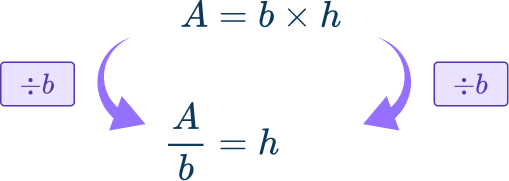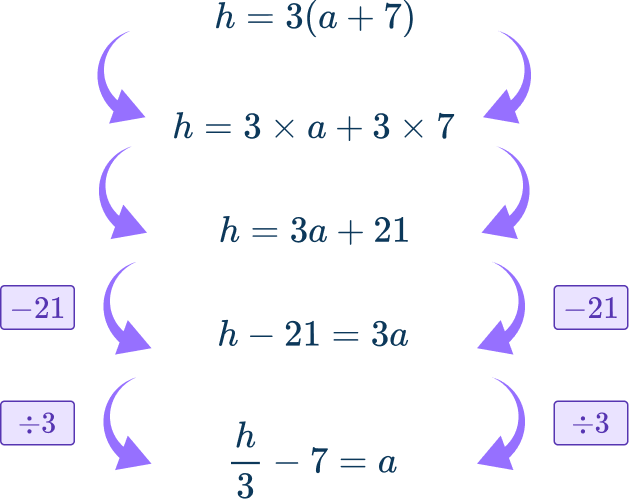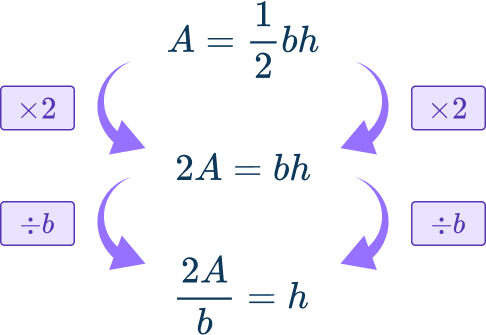High Impact Tutoring Built By Math Experts
Personalized standards-aligned one-on-one math tutoring for schools and districts
In order to access this I need to be confident with:
Expanding expressions Algebraic expressions Square root Factoring out theRearranging equations
Here you will learn about rearranging equations, including how to solve equations for a particular variable as well as change the subject of formulas.
Students first learn how to rearrange equations in 8 th grade math when they learn how to put linear equations in slope intercept form, y=mx+b. They expand this knowledge as they progress through Algebra I and Algebra II.
What is rearranging equations?
Rearranging equations means to solve an equation for a particular variable or change the subject of the equation to write it in a different way.
The strategies used to rearrange an equation are the same as when solving an equation for an unknown variable, which means using inverse operations (in the opposite order of the order of operations) to change the subject of the formula.
Let’s look at a side-by-side comparison of solving an equation for the unknown variable and rearranging an equation for a particular variable (changing the subject).
Remember, when solving any equation, be sure to do the same exact thing to both sides of the equal sign.

Step-by-step guide: Solving equations
What is rearranging equations?

Common Core State Standards
How does this apply to high school math?
- High School Algebra – Creating Equations (HSA-CED.A.4)
Rearrange formulas to highlight a quantity of interest, using the same reasoning as in solving equations. For example, rearrange Ohm’s law V=IR to highlight resistance R.
![[FREE] Rearranging Equations Worksheet (High School)](https://thirdspacelearning.com/wp-content/uploads/2024/04/Rearranging-Equations-Worksheet-listing-image.png)
[FREE] Rearranging Equations Worksheet (High School)
![[FREE] Rearranging Equations Worksheet (High School)](https://thirdspacelearning.com/wp-content/uploads/2024/04/Rearranging-Equations-Worksheet-listing-image.png)
Use this worksheet to check your high school students’ understanding of rearranging equations. 15 questions with answers to identify areas of strength and support!
DOWNLOAD FREE![[FREE] Rearranging Equations Worksheet (High School)](https://thirdspacelearning.com/wp-content/uploads/2024/04/Rearranging-Equations-Worksheet-listing-image.png)
[FREE] Rearranging Equations Worksheet (High School)
![[FREE] Rearranging Equations Worksheet (High School)](https://thirdspacelearning.com/wp-content/uploads/2024/04/Rearranging-Equations-Worksheet-listing-image.png)
Use this worksheet to check your high school students’ understanding of rearranging equations. 15 questions with answers to identify areas of strength and support!
DOWNLOAD FREEHow to rearrange equations
In order to rearrange equations:
- Identify the variable you need to isolate.
- Use inverse operations and/or the distributive property to isolate the variable.
- State the solution and simplify if possible.
Rearranging equations examples
Example 1: two step
Solve the equation for y.
5x+5y=10- Identify the variable you need to isolate.
In this case, solve the equation for y.

2Use inverse operations and/or the distributive property to isolate the variable.
First, subtract 5x from both sides of the equation because subtraction is the inverse operation to addition.

Then, divide both sides of the equation by 5 because division is the inverse operation of multiplication. Remember to divide every term by 5 .

3State the solution and simplify if possible.
y=2-xExample 2: distributive property
Rearrange the equation for x.
p=2(x-3)Identify the variable you need to isolate.
In this case, solve for x.

Use inverse operations and/or the distributive property to isolate the variable.
Use the same solving strategies as you would when solving a regular equation for an unknown. In this case, first distribute the 2 to the parenthesis.
p=2\times{x}-2\times{3}
p=2x-6
Then add 6 to both sides of the equation because addition is the inverse operation of subtraction.

Then divide both sides of the equation by 2 , because division is the inverse operation of multiplication.

State the solution and simplify if possible.
Example 3: change the subject of a formula
Solve the formula for h.
A=bhIdentify the variable you need to isolate.
Change the subject of the formula from A to h.

Use inverse operations and/or the distributive property to isolate the variable.
In this case, to solve the formula for h , divide both sides of the formula by b because division is the inverse operation of multiplication.

State the solution and simplify if possible.
By solving for h , the subject of the formula changed from A to h.
Example 4: equations with x²
Solve the equation for x.
y=x^{2}-4Identify the variable you need to isolate.
In this case, solve for x.

Use inverse operations and/or the distributive property to isolate the variable.
To solve this equation for x, first, add 4 to both sides because addition is the inverse operation of subtraction.

Then, take the square root of both sides because square root is the inverse operation of squaring (square root undoes squaring).

*Note: Remember, the square root has both a positive and negative root
State the solution and simplify if possible.
The solutions are x=\pm\sqrt{y+4}.
Example 5: questions involving √x
Solve the equation for x.
y=\sqrt{3x}+nIdentify the variable you need to isolate.
In this case, solve the equation for x.

Use inverse operations and/or the distributive property to isolate the variable.
To solve the equation for x, first subtract n from both sides of the equation.

Next, square both sides of the equation.

Then, divide both sides of the equation by 3 .

State the solution and simplify if possible.
You can leave the answer this way or distribute the binomial, (y-n)^2 to get y^2-2yn+n^2.
So the solution can be written as:
x=\cfrac{y^{2}-2yn+n^{2}}{3}
How to rearrange equations
In order to rearrange equations with more than 1 of the same variable:
- Identify the variables you need to isolate.
- Use inverse operations to isolate the variables.
- Apply the strategy of factoring.
- State the solution and simplify if possible.
Example 6: more than 1 of the same variable
Rearrange \cfrac{a}{3}=\cfrac{2-7x}{x-5} to make x the subject.
Identify the variables you need to isolate.
Solve the equation for x. Notice how there are two terms with the variable x.

Use inverse operations to isolate the variables.
To solve the equation for x, first multiply both sides of the equation by 3 to remove the denominator of the fraction from the left side of the equals sign. Remember to distribute the 3 to the numerator.

Next, multiply both sides of the equation by the binomial (x-5) to remove the denominator on the right hand side of the equals sign. Remember to distribute a.

Next, rearrange the variables so that the x ’s are on the same side of the equation. So, add 5a to both sides of the equation because addition is the inverse of subtraction.

Next, add 21x to both sides of the equation because addition is the inverse operation of subtraction.

Apply the strategy of factoring.
In order to write the equation with only one x term, apply the strategy of factoring.
x(a+21)=6+5a
Finally, divide both sides by the binomial (a+21) to isolate x.

State the solution and simplify if possible.
Example 7: factoring of the variable is required
Solve the equation for z.
y=\cfrac{2xz}{z-x}Identify the variables you need to isolate.
Solve the equation for z. Notice how there are two terms with the variable z.

Use inverse operations to isolate the variables.
First, multiply both sides of the equation by the binomial (z-x) and distribute.

Bring all the z terms to one side of the equation and the terms without z ’s to the other side.
Add xy to both sides, then subtract 2xz from both sides.

Apply the strategy of factoring.
Use the strategy of factoring to factor out z so that there is only one term with the variable z.
z(y-2x)=xy
Lastly, divide both sides by the binomial (y-2x) to isolate z.

State the solution and simplify if possible.
Step-by-step guide: Factoring GCF
Teaching tips for rearranging equations
- Demonstrate side-by-side examples of solving equations for a numerical solution with an equation that requires rearrangement of variables so that students can conceptualize that the steps are the same.
- Rearranging equations is a skill that is seen on exam questions such as the SAT or college placement tests, so infuse practice SAT exam questions as warm up questions or “do nows.”
Easy mistakes to make
- Forgetting to apply the inverse operation to both sides of the equation
For example, with the equation y=5x-3 , forgetting to add 3 to both sides of the equation.
y≠ 5x-3+3
y≠ 5x
Instead,
\begin{aligned}y+3&=5x-3+3 \\\\ y+3&=5x \\\\ \cfrac{y+3}{5}&=\cfrac{5x}{5} \\\\ \cfrac{y+3}{5}&=x \end{aligned}
- Using the incorrect inverse operation
For example, changing the subject from A to b formula:
A=bh (multiplying both sides of the formula by h instead of dividing by h )
A\times{h}=bh\times{h}
\begin{aligned}A&=bh \\\\ \cfrac{A}{h}&=\cfrac{bh}{h} \end{aligned}
- Forgetting to include the negative root of a square root
For example, when taking the square root to undo a squared term, remember to include the positive root and the negative root.
\sqrt{x} should be written as \pm\sqrt{x} .
- Forgetting to factor when the subject is in more than one term
For example, when solving the equation 2x+3xy=3y for x, you must factor the x from the left hand side of the equation so that it is only in one term and not two terms.
\begin{aligned}x(2+3y)&=3y \\ x&=\cfrac{3y}{2+3y} \end{aligned}
Related math equation lessons
Rearranging equations practice problems
1. Make a the subject of the formula h=3(a+7).




Solve the equation, h=3(a+7) for the variable a by first distributing the 3 into the binomial (a+7) then isolating a.

2. Solve the formula for h.
A=\cfrac{1}{2} \, bh




Solving the formula A=\cfrac{1}{2} \, bh for h means to change the subject from A to h.

3. Make c the subject of the formula g=\sqrt{5 c-r}




Solve the equation for c\text{:}

4. Solve p=b^{2}-9k for b.




Isolate the variable b\text{:}

5. Make d the subject of the formula y=\cfrac{3d+1}{4d}.




Rearrange the equation so that only one term contains the variable d then isolate this on one side of the equals sign:

6. Make e the subject of the formula.
\cfrac{q}{3}=\cfrac{6-2e}{e+1}




Rearrange the equation so that only one term contains the variable e then isolate this on one side of the equals sign:

Rearranging equations FAQs
Yes, you can rearrange any algebraic equation by changing the subject.
Yes, sometimes rearranging quadratic equations, linear equations, and/or any algebraic equation might be helpful when trying to graph them.
The next lessons are
Still stuck?
At Third Space Learning, we specialize in helping teachers and school leaders to provide personalized math support for more of their students through high-quality, online one-on-one math tutoring delivered by subject experts.
Each week, our tutors support thousands of students who are at risk of not meeting their grade-level expectations, and help accelerate their progress and boost their confidence.

Find out how we can help your students achieve success with our math tutoring programs.
[FREE] Common Core Practice Tests (3rd to 8th Grade)
Prepare for math tests in your state with these 3rd Grade to 8th Grade practice assessments for Common Core and state equivalents.
Get your 6 multiple choice practice tests with detailed answers to support test prep, created by US math teachers for US math teachers!